|
|
||
|---|---|---|
| .. | ||
| README.md | ||
| weather-widget.png | ||
| weather.lua | ||
README.md
Weather widget
Note that widget uses the Arc icon theme, so it should be installed first under /usr/share/icons/Arc/ folder.
Customization
It is possible to customize widget by providing a table with all or some of the following config parameters:
| Name | Default | Description |
|---|---|---|
font |
Play 9 |
Font |
city |
Montreal,ca |
City name and country code, more info |
api_key |
none | API key, required |
units |
metric |
metric for celsius, imperial for fahrenheit |
both_units_widget |
false |
show temperature in both units (15°C (59°F)) or in one (15°C) |
both_units_popup |
false |
same as above but for popup |
Example:
weather_widget({
api_key = 'your-api-key',
units = 'imperial',
font = 'Ubuntu Mono 9'
}),
Installation
-
Install lua socket - to make HTTP calls to get the weather information.
$ sudo apt-get install lua-socket -
Download json parser for lua from github.com/rxi/json.lua and place it under ~/.config/awesome/ (don't forget to star a repo ):
wget -P ~/.config/awesome/ https://raw.githubusercontent.com/rxi/json.lua/master/json.lua -
Clone this repo under ~/.config/awesome/:
git clone https://github.com/streetturtle/awesome-wm-widgets.git ~/.config/awesome/ -
Get Open Weather Map app id here: openweathermap.org/appid.
-
Require weather widget at the beginning of rc.lua:
local weather_widget = require("awesome-wm-widgets.weather-widget.weather") -
Add widget to the tasklist:
s.mytasklist, -- Middle widget { -- Right widgets layout = wibox.layout.fixed.horizontal, ... --default weather_widget({api_key = 'your-api-key'}), --customized weather_widget({ api_key = 'your-api-key', units = 'imperial', font = 'Ubuntu Mono 9' }) ...
You can read how it works in more details here
